Tennessee v. Garner: Examining Police Use of Deadly Force
VerifiedAdded on 2023/06/03
|5
|734
|450
Case Study
AI Summary
This case study examines the U.S. Supreme Court case Tennessee v. Garner (1985), which challenged the constitutionality of a Tennessee statute authorizing police to use deadly force to prevent the escape of an unarmed suspect. The case originated from a 1974 incident where a Memphis police officer shot and killed an unarmed fleeing suspect, Garner. The Supreme Court ruled that such use of deadly force is unconstitutional unless the officer believes the suspect poses a significant threat of death or serious physical injury to the officer or others. This landmark decision set a precedent, limiting police use of deadly force and emphasizing the importance of protecting suspects' rights. The case underscores the judiciary's role in curbing potential police overreach and upholding constitutional principles.
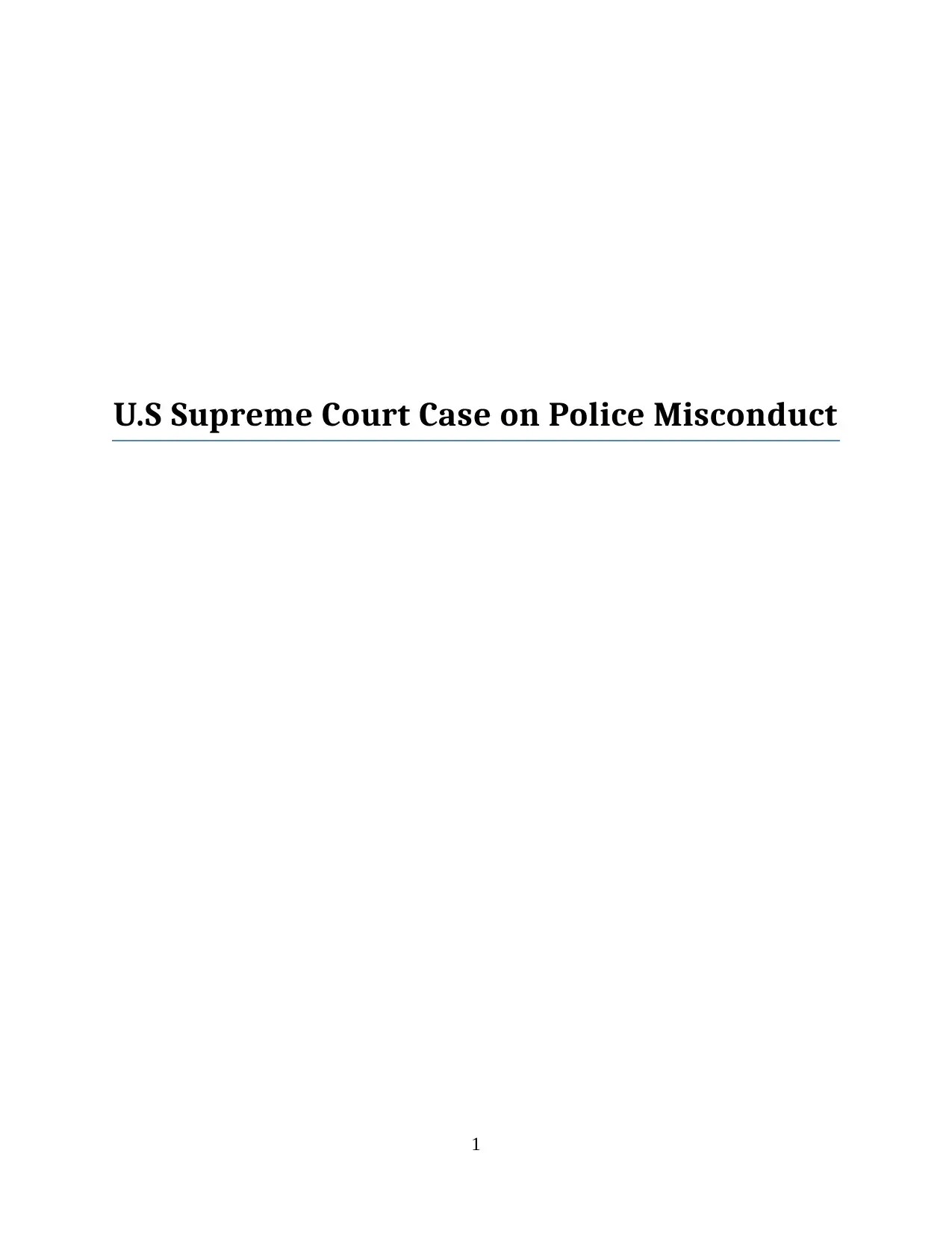
U.S Supreme Court Case on Police Misconduct
1
1
Paraphrase This Document
Need a fresh take? Get an instant paraphrase of this document with our AI Paraphraser
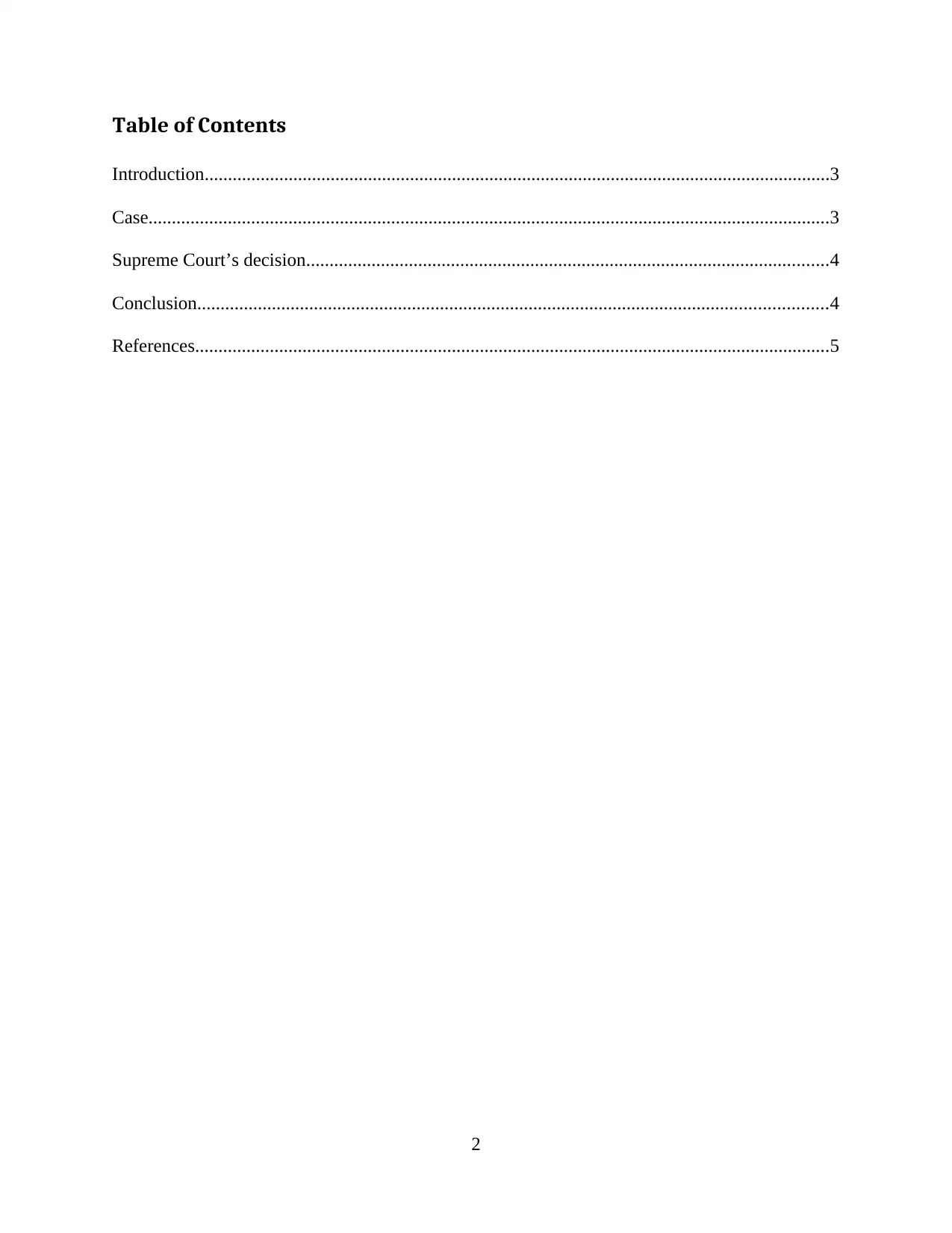
Table of Contents
Introduction......................................................................................................................................3
Case..................................................................................................................................................3
Supreme Court’s decision................................................................................................................4
Conclusion.......................................................................................................................................4
References........................................................................................................................................5
2
Introduction......................................................................................................................................3
Case..................................................................................................................................................3
Supreme Court’s decision................................................................................................................4
Conclusion.......................................................................................................................................4
References........................................................................................................................................5
2
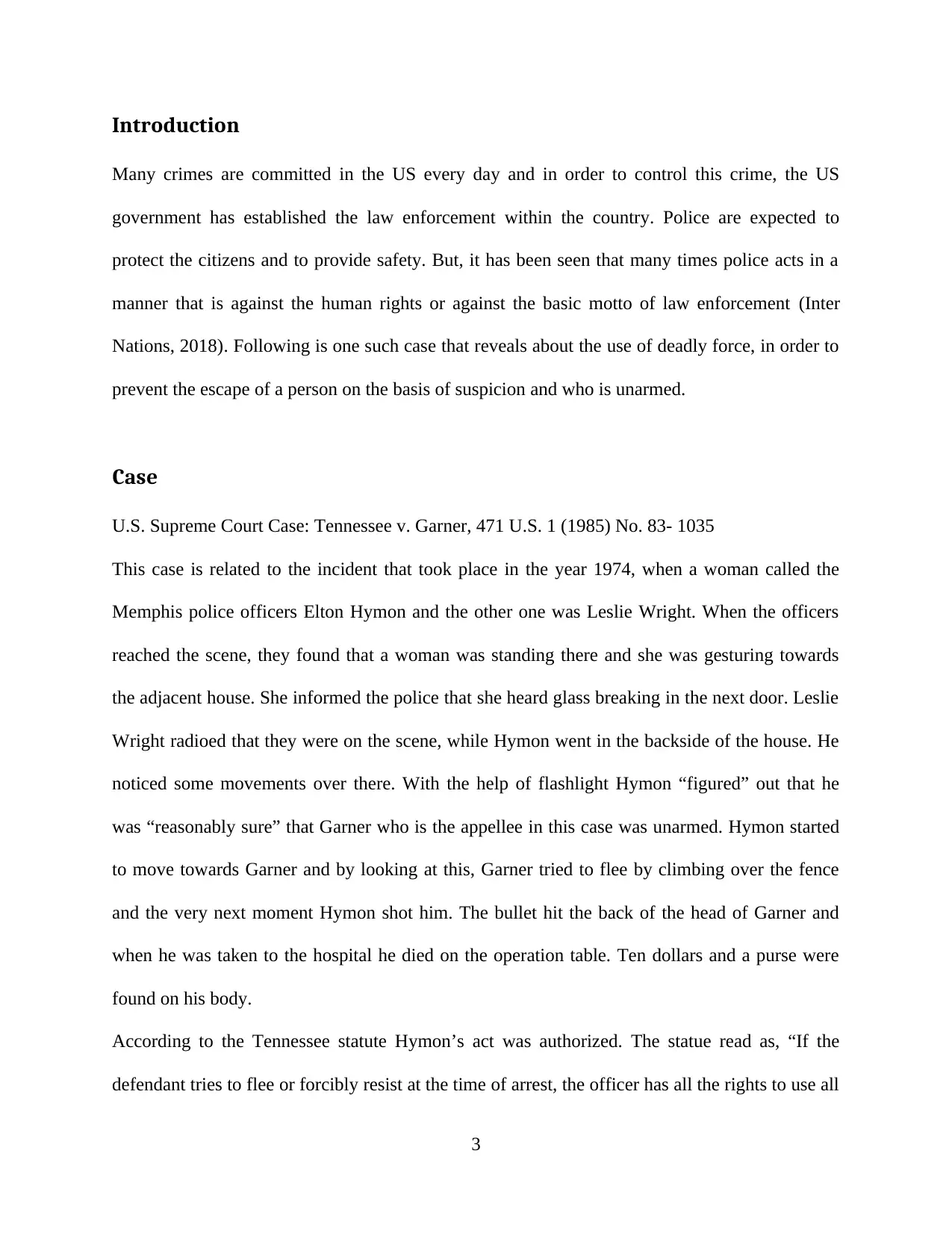
Introduction
Many crimes are committed in the US every day and in order to control this crime, the US
government has established the law enforcement within the country. Police are expected to
protect the citizens and to provide safety. But, it has been seen that many times police acts in a
manner that is against the human rights or against the basic motto of law enforcement (Inter
Nations, 2018). Following is one such case that reveals about the use of deadly force, in order to
prevent the escape of a person on the basis of suspicion and who is unarmed.
Case
U.S. Supreme Court Case: Tennessee v. Garner, 471 U.S. 1 (1985) No. 83- 1035
This case is related to the incident that took place in the year 1974, when a woman called the
Memphis police officers Elton Hymon and the other one was Leslie Wright. When the officers
reached the scene, they found that a woman was standing there and she was gesturing towards
the adjacent house. She informed the police that she heard glass breaking in the next door. Leslie
Wright radioed that they were on the scene, while Hymon went in the backside of the house. He
noticed some movements over there. With the help of flashlight Hymon “figured” out that he
was “reasonably sure” that Garner who is the appellee in this case was unarmed. Hymon started
to move towards Garner and by looking at this, Garner tried to flee by climbing over the fence
and the very next moment Hymon shot him. The bullet hit the back of the head of Garner and
when he was taken to the hospital he died on the operation table. Ten dollars and a purse were
found on his body.
According to the Tennessee statute Hymon’s act was authorized. The statue read as, “If the
defendant tries to flee or forcibly resist at the time of arrest, the officer has all the rights to use all
3
Many crimes are committed in the US every day and in order to control this crime, the US
government has established the law enforcement within the country. Police are expected to
protect the citizens and to provide safety. But, it has been seen that many times police acts in a
manner that is against the human rights or against the basic motto of law enforcement (Inter
Nations, 2018). Following is one such case that reveals about the use of deadly force, in order to
prevent the escape of a person on the basis of suspicion and who is unarmed.
Case
U.S. Supreme Court Case: Tennessee v. Garner, 471 U.S. 1 (1985) No. 83- 1035
This case is related to the incident that took place in the year 1974, when a woman called the
Memphis police officers Elton Hymon and the other one was Leslie Wright. When the officers
reached the scene, they found that a woman was standing there and she was gesturing towards
the adjacent house. She informed the police that she heard glass breaking in the next door. Leslie
Wright radioed that they were on the scene, while Hymon went in the backside of the house. He
noticed some movements over there. With the help of flashlight Hymon “figured” out that he
was “reasonably sure” that Garner who is the appellee in this case was unarmed. Hymon started
to move towards Garner and by looking at this, Garner tried to flee by climbing over the fence
and the very next moment Hymon shot him. The bullet hit the back of the head of Garner and
when he was taken to the hospital he died on the operation table. Ten dollars and a purse were
found on his body.
According to the Tennessee statute Hymon’s act was authorized. The statue read as, “If the
defendant tries to flee or forcibly resist at the time of arrest, the officer has all the rights to use all
3
⊘ This is a preview!⊘
Do you want full access?
Subscribe today to unlock all pages.

Trusted by 1+ million students worldwide
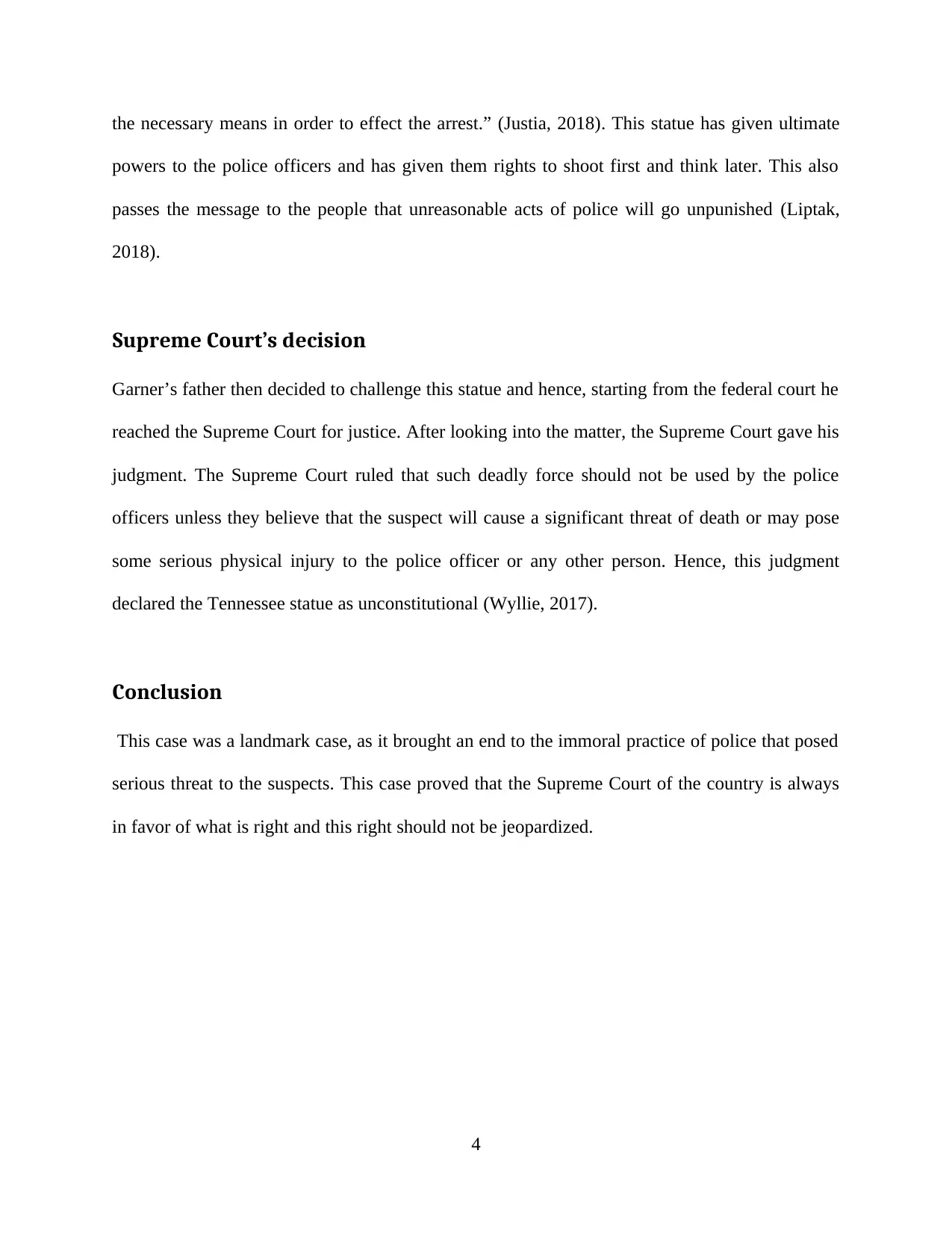
the necessary means in order to effect the arrest.” (Justia, 2018). This statue has given ultimate
powers to the police officers and has given them rights to shoot first and think later. This also
passes the message to the people that unreasonable acts of police will go unpunished (Liptak,
2018).
Supreme Court’s decision
Garner’s father then decided to challenge this statue and hence, starting from the federal court he
reached the Supreme Court for justice. After looking into the matter, the Supreme Court gave his
judgment. The Supreme Court ruled that such deadly force should not be used by the police
officers unless they believe that the suspect will cause a significant threat of death or may pose
some serious physical injury to the police officer or any other person. Hence, this judgment
declared the Tennessee statue as unconstitutional (Wyllie, 2017).
Conclusion
This case was a landmark case, as it brought an end to the immoral practice of police that posed
serious threat to the suspects. This case proved that the Supreme Court of the country is always
in favor of what is right and this right should not be jeopardized.
4
powers to the police officers and has given them rights to shoot first and think later. This also
passes the message to the people that unreasonable acts of police will go unpunished (Liptak,
2018).
Supreme Court’s decision
Garner’s father then decided to challenge this statue and hence, starting from the federal court he
reached the Supreme Court for justice. After looking into the matter, the Supreme Court gave his
judgment. The Supreme Court ruled that such deadly force should not be used by the police
officers unless they believe that the suspect will cause a significant threat of death or may pose
some serious physical injury to the police officer or any other person. Hence, this judgment
declared the Tennessee statue as unconstitutional (Wyllie, 2017).
Conclusion
This case was a landmark case, as it brought an end to the immoral practice of police that posed
serious threat to the suspects. This case proved that the Supreme Court of the country is always
in favor of what is right and this right should not be jeopardized.
4
Paraphrase This Document
Need a fresh take? Get an instant paraphrase of this document with our AI Paraphraser
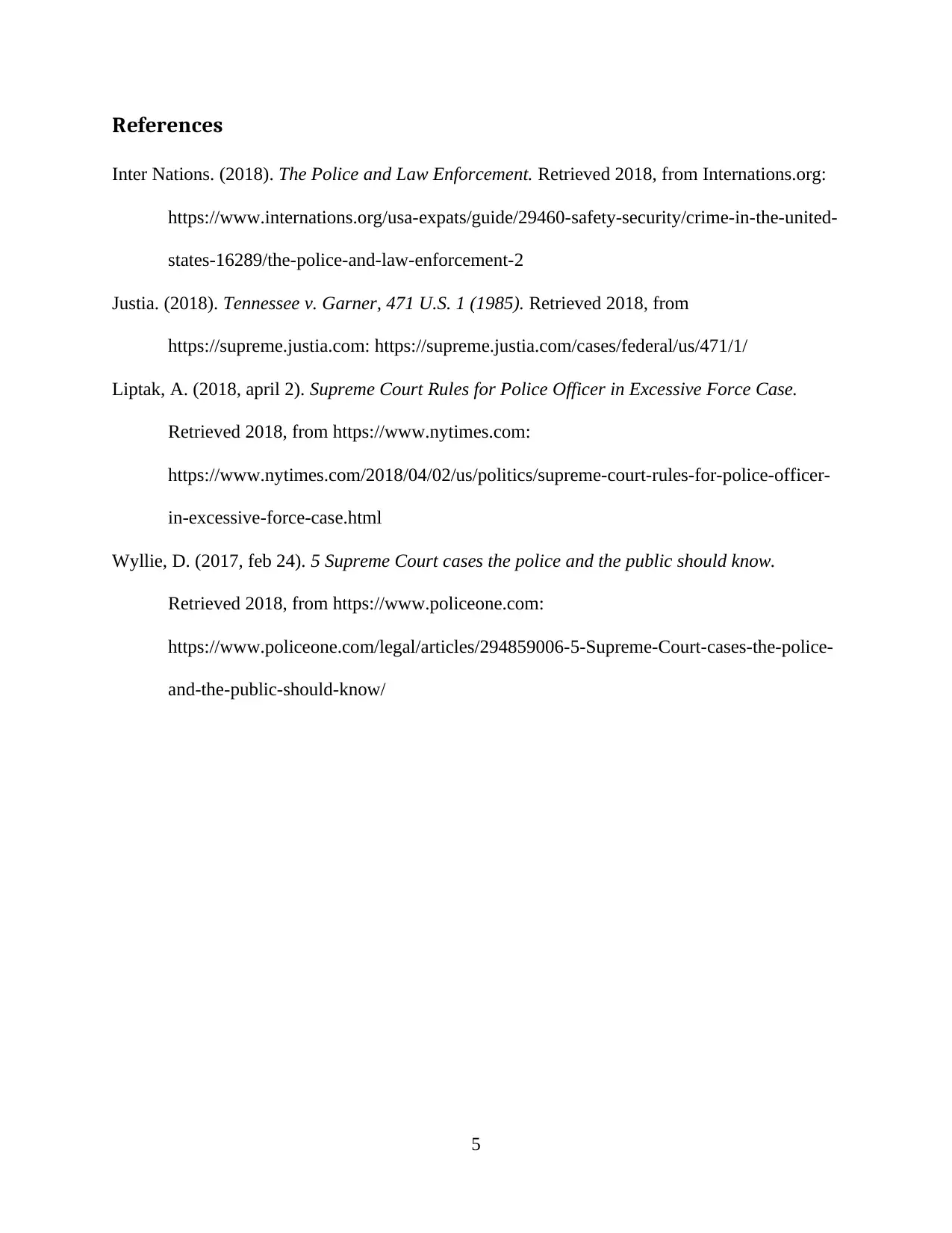
References
Inter Nations. (2018). The Police and Law Enforcement. Retrieved 2018, from Internations.org:
https://www.internations.org/usa-expats/guide/29460-safety-security/crime-in-the-united-
states-16289/the-police-and-law-enforcement-2
Justia. (2018). Tennessee v. Garner, 471 U.S. 1 (1985). Retrieved 2018, from
https://supreme.justia.com: https://supreme.justia.com/cases/federal/us/471/1/
Liptak, A. (2018, april 2). Supreme Court Rules for Police Officer in Excessive Force Case.
Retrieved 2018, from https://www.nytimes.com:
https://www.nytimes.com/2018/04/02/us/politics/supreme-court-rules-for-police-officer-
in-excessive-force-case.html
Wyllie, D. (2017, feb 24). 5 Supreme Court cases the police and the public should know.
Retrieved 2018, from https://www.policeone.com:
https://www.policeone.com/legal/articles/294859006-5-Supreme-Court-cases-the-police-
and-the-public-should-know/
5
Inter Nations. (2018). The Police and Law Enforcement. Retrieved 2018, from Internations.org:
https://www.internations.org/usa-expats/guide/29460-safety-security/crime-in-the-united-
states-16289/the-police-and-law-enforcement-2
Justia. (2018). Tennessee v. Garner, 471 U.S. 1 (1985). Retrieved 2018, from
https://supreme.justia.com: https://supreme.justia.com/cases/federal/us/471/1/
Liptak, A. (2018, april 2). Supreme Court Rules for Police Officer in Excessive Force Case.
Retrieved 2018, from https://www.nytimes.com:
https://www.nytimes.com/2018/04/02/us/politics/supreme-court-rules-for-police-officer-
in-excessive-force-case.html
Wyllie, D. (2017, feb 24). 5 Supreme Court cases the police and the public should know.
Retrieved 2018, from https://www.policeone.com:
https://www.policeone.com/legal/articles/294859006-5-Supreme-Court-cases-the-police-
and-the-public-should-know/
5
1 out of 5
Related Documents
Your All-in-One AI-Powered Toolkit for Academic Success.
+13062052269
info@desklib.com
Available 24*7 on WhatsApp / Email
![[object Object]](/_next/static/media/star-bottom.7253800d.svg)
Unlock your academic potential
Copyright © 2020–2025 A2Z Services. All Rights Reserved. Developed and managed by ZUCOL.



